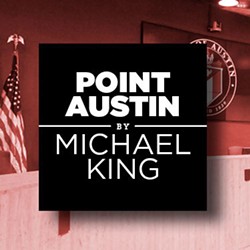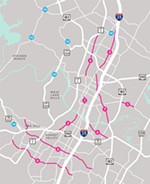Point Austin: Let Us Begin
The transportation bond represents useful and necessary progress
By Michael King, Fri., Oct. 28, 2016

Unlike seemingly every other Austinite, I don't profess to be a traffic engineer. I don't know certainly the best way to solve Austin's traffic problems – although I'm convinced leveling more buildings and eating up more land for motor vehicle lanes (aka the Katy Freeway Solution) is not the way to go. After a personal, self-paced online seminar in the city of Austin's transportation planning methods ("Corridor Improvement Programs"), I do claim a reasonable grasp of what the city hopes to do with the largest share of the Mobility Bond ($482 million for "Smart Corridors"). While I don't expect those planned projects to deliver miracles – either for "vehicle throughput" or for shifting the load more broadly across other transportation modes – the projects appear to be necessary steps in the right direction, and an attempt to keep pace with badly overdue infrastructure upgrades and the next decade of metropolitan growth.
Will they solve all our transportation problems, or end the expense? Of course not, and it's disingenuous of opponents to pretend that the bond is a shell game that hides the long-term expense. All the City Council and public discussions of the bond, beginning last May, made it quite clear that the city is attempting to take a large bite out of the citywide transportation agenda, but that additional investments will certainly be necessary. It's no secret that metropolitan Austin is rapidly outgrowing its essential infrastructure, and that if we intend to maintain the city's prosperity and quality of life, it's not a free ride.
It's worth noting that "Honest Transportation Solutions" – the political action committee whose propaganda belies its name – blasts the bond as too expensive, but then proposes a nearly $700 million alternative devoted entirely to regional highways, while ignoring the central city roadways expected to offload all that highway traffic. It's a suburbanized solution at once selfish and shortsighted – it simply ignores what will happen at the end of the suburban highway funnels. All those additional motor vehicles need to go somewhere, and the corridor roadways aren't adequate to accommodate them.
Dishonest Opposition
A few other myths about the bond and its consequences need puncturing:
Public Input: While the formal bond process itself (beginning this year instead of last) was unfortunately truncated, every single corridor plan began with public and neighborhood outreach, incorporating as fully as possible the local sentiment about what was needed on roads like North and South Lamar, or Airport Boulevard, etc., and how best to incorporate those stated needs. Moreover, the 10-1 Council itself deliberated and adjusted the projects over several months, and no council member was entirely happy with the overall result – reflecting that geographic and political compromises were inevitable parts of the process.
Transparency: Bond opponents are using this term oddly, to mean the three "buckets" of the bond (regional highways, central city corridors, and local multimodal projects) should have been split up, to be voted on separately. Yet the buckets are complementary, and broad city support is dependent on the geographic and multimodal balance of the bond. What the opponents really mean, again, is that they want regional highways only, and want to rely on traditionally heavier west side/suburban voting to veto those projects benefiting other parts of the city, and other travel modes. That's neither transparent nor fair.
Trust: Opponents point to an April "Transportation Effectiveness Audit" as well as the March "Tumlin Report" ("Transportation Strategy Recommendations") to suggest that the city transportation staff is not ready to take on these large projects. The audit in fact recommends greater collaboration among city departments, a more proactive approach to transportation, and a stronger focus on safety – all standards built into the bond ordinance. The Tumlin report firmly recommends, "Implement the Corridor Plans." We either enable the professionals we hire to do their jobs (under the policy supervision of Council) or surrender to cheap cynicism.
The Missing Piece
Beyond all these myths is one missing element: a public commitment to substantial investments in mass transit, most prominently rail. Council briefly considered a separate rail project, but with the bond already sizable, and considering the strong 2014 rejection by the voters, and some council members having noisily joined in that rejection, that was a non-starter. Still, it doesn't take a traffic engineer to realize that Austin/Travis County is way too car-dependent – and if we can't muster the citywide willingness to spend significant dollars on mass transit, all the road projects in this bond and the next ... and the next ... will do nothing but keep us riding in place. Voters who prefer motor vehicles over all else will especially and finally need to realize that getting other people out of their cars, into alternate modes of travel including mass transit, helps them too.
In the meantime, we need to start fixing the roadways, redesigning the central corridors, and providing other ways to get around. This bond will start that process.
Got something to say on the subject? Send a letter to the editor.










